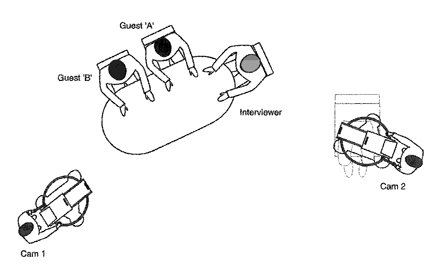One plus two (1)
The ‘one interviewer, two guest’ scenario has the same basic rules as the one plus one, but with a couple of variations. The interviewer can either be put between the guests, or to one side.
Interviewer to one side
This is the easier arrangement to shoot, particularly if you have only two cameras.
Two cameras
The interviewer has his own camera (Cam 1). This can get either a single (MCU or MS) of the interviewer, or it can crab slightly around to the right and get a 3-shot.
Camera 2 gets the single of either guest, a 2-shot of ‘A’ and ‘B’, or a 3-shot.
In this situation you need to throw in a lot of reaction shots from camera 1 while camera 2 reframes.
Three cameras
Now it becomes straightforward.
The interviewer works to camera (Cam 1). This gets either a single (MCU or MS), or crabs to the right to get a 3-shot.
Camera 2 gets either a single of guest ‘A’, a 2-shot of ‘A’ and ‘B’, or a 3-shot.
Camera 3 can get a single of either guest, or a 2-shot of ‘A’ and ‘B’.
Generally we would have camera 2 pick up the single of the guest in the middle, while camera 3 picks up guest ‘B’. This gives good two-eyed shots on both guests at the same time.
This arrangement works particularly well if the guests are friendly to each other. You can get nice 2-shots of guest ‘B’ listening to guest ‘A’, which is useful in a relaxed chat show, where you might want to see someone laughing at a story being told. It can work between politicians, but only if they are polite. With your interviewer trapped at one end of the desk it is very hard for them to jump in and take control if the guests become too obstreperous.
One plus two, two cameras

One plus two, three cameras

